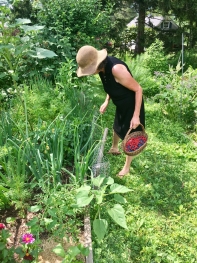
Nancy DuBrule-Clemente has encountered a few unwanted plants—aka weeds—during her 50-year career in the state’s landscape. Graduating from UConn in the 1970s, DuBrule-Clemente went to work in the landscape profession and stayed.
Many know DuBrule-Clemente for the destination garden center and landscape company she founded in 1983, Natureworks. She ran the business at its current location on Forest Road (Route 22) in Northford since 1990 and has promoted nature-friendly, organic approaches to ornamental landscapes since the beginning.
How does a horticulturist with 50 years of experience manage the unwanted plants in her home landscape?
“My home gardens are not so neat and tidy as people might expect,” she says. “I don’t get too worked up about hensbit or creeping Charlie. Some clover is okay. I don’t worry about having a nice lawn.
“I haven’t used conventional mulch in over 12 years,” she adds.
Mulch, she says, generates a weedy cycle that gets ahead of the gardener quickly.
Her replacement for ornamental mulch?
“I use dense plantings that fill the garden and leave no soil exposed. They act as living mulch,” she says and adds that leaf litter is great mulch, too.
“I use a lot of self-sowing native plants such as asters, goldenrods, and fleabane,” she says. “I let them self-seed and spread by roots, but if they’re getting too aggressive, I edit them by cutting off the flower heads before they go to seed, or I trim them to the ground.”
When planted into an adequately prepared area, they reduce or eliminate the need for shredded wood mulch. Living mulch is not a new idea; witness the wide use of Japanese pachysandra. Now, designers and gardeners are choosing more native plants for this purpose.
Site preparation is key to success. Take the time to clear the living mulch area of unwanted plants. For instance, use a 12-inch cover of raw wood chips or a plastic smother for up to a year. This length of time eliminates most existing plants. It may be more time than we like, but it increases the success of the living mulch. After the space is as weed-free as possible, consider one or more of these plants to former this living layer.
She adds, “In my home gardens, I’m looking for a state of balance. For me, that means covering the ground and feeding the pollinators.”
Read more recommendations from Nancy. See the complete article at Zip06/TheDay.
